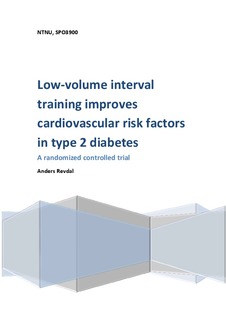| dc.contributor.advisor | Ingul, Charlotte | nb_NO |
| dc.contributor.author | Revdal, Anders | nb_NO |
| dc.date.accessioned | 2014-12-19T14:24:17Z | |
| dc.date.available | 2014-12-19T14:24:17Z | |
| dc.date.created | 2014-06-27 | nb_NO |
| dc.date.issued | 2014 | nb_NO |
| dc.identifier | 732977 | nb_NO |
| dc.identifier.uri | http://hdl.handle.net/11250/264919 | |
| dc.description.abstract | Background: Type 2 diabetes (T2D) is predicted to affect about 500 million individuals by 2030, and is closely linked to cardiovascular disease. Exercise is considered a cornerstone in both the prevention and treatment of T2D, but despite the clear-cut evidence and well established recommendations few patients with T2D exercise enough according to today’s guidelines.
Objectives: To compare two different time-efficient high intensity exercise protocols in patients with T2D, and to investigate the effect on glycemic control and cardiovascular risk factors.
Methods: Subjects with T2D were recruited and randomly assigned to either low-volume high intensity interval training (HIT) or extremely low-volume sprint interval training (SIT). Both groups exercised three days a week for 12 weeks. Changes in glycosylated hemoglobin(HbA1c), aerobic capacity (VO2peak), blood lipids, blood pressure and body composition were measured.
Results: HIT and SIT combined reduced HbA1c significantly (-0.54 percentage points, p = 0.005) only in the patients with the poorest glycemic control at baseline. Both HIT and SIT improved VO2peak, with no significant difference between groups. HIT, but not SIT, improved body fat percentage and visceral fat area. In hypertensive subjects blood pressure was reduced following HIT and SIT combined.
Conclusion: Time-efficient interval training of high intensity can improve glycemic control in type 2 diabetes-patients with poorly controlled hyperglycemia, but not in wellcontrolled subjects. Aerobic capacity, body composition and hypertension can be improved in type 2 diabetes following substantially less weekly time of training than currently recommended, given that intensity of training is high. | nb_NO |
| dc.language | eng | nb_NO |
| dc.publisher | Norges teknisk-naturvitenskapelige universitet, Det medisinske fakultet, Institutt for sirkulasjon og bildediagnostikk | nb_NO |
| dc.title | Low-volume interval training improves cardiovascular risk factors in type 2 diabetes: A randomized controlled trial | nb_NO |
| dc.type | Master thesis | nb_NO |
| dc.contributor.department | Norges teknisk-naturvitenskapelige universitet, Det medisinske fakultet, Institutt for sirkulasjon og bildediagnostikk | nb_NO |
